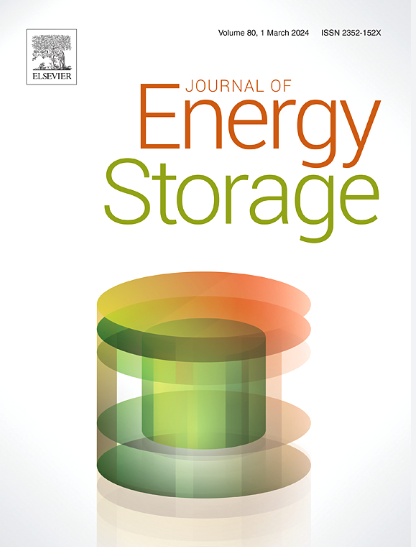基于三周期最小表面(TPMS)的金属晶格散热器与不同相变材料集成以增强电子器件热管理的数值和实验分析
IF 8.9
2区 工程技术
Q1 ENERGY & FUELS
引用次数: 0
摘要
本文研究了三周期最小表面(TPMS)金属晶格散热器与三种相变材料(RT55、RT42和RT31)集成的热性能。目的是通过评估PCM热特性和晶格几何对传热和相变动力学的影响来优化高性能电子器件的热管理。采用有限体积法对四种基于tpms的设计在单向热流条件下进行了八面体(P3)、波形(P2)、液滴(P4)和原体(P6)的数值分析。模拟考虑了瞬态基本温度和平均温度分布、液体馏分级数和完成熔化的时间。结果表明,原始设计始终优于其他配置,RT31的最低基础温度为72°C,仅在491秒内完成相变,比波形设计快28%,比液滴设计快50%以上。相反,液滴设计表现出最慢的热响应,RT55的基温为90℃,熔化时间超过3500 s。在pcm中,RT31由于其较低的熔化温度而表现出优异的热缓冲能力,其平均稳定温度比RT42和RT55低至少5°C。该研究强调了对称晶格结构的重要性,例如在原始设计中,对于提高传热效率和缩短相变持续时间。这项工作有助于推进基于tpms的散热器设计,并为将PCMs集成到下一代能量存储和电子冷却热管理系统中提供可操作的见解。本文章由计算机程序翻译,如有差异,请以英文原文为准。
Numerical and experimental analysis of triply periodic minimal surface (TPMS)-based metal lattice heat sinks integrated with different phase change materials for enhanced thermal management of electronics
This study investigates the thermal performance of Triply Periodic Minimal Surface (TPMS)-based metal lattice heat sinks integrated with three Phase Change Materials (PCMs): RT55, RT42, and RT31. The objective is to optimize thermal management for high-performance electronics by evaluating the influence of PCM thermal properties and lattice geometry on heat transfer and phase change dynamics. Four TPMS-based designs octahedral (P3), waveform (P2), droplet (P4) and primitive (P6) were numerically analyzed under unidirectional heat flux conditions using a finite volume method. The simulations considered transient base and average temperature profiles, liquid fraction progression, and time to complete melting. Results revealed that primitive design consistently outperformed other configurations, achieving the lowest base temperature of 72 °C with RT31 and completing phase change in just 491 s, 28 % faster than waveform design and over 50 % faster than droplet design. Conversely, droplet design exhibited the slowest thermal response, with a base temperature of 90 °C and a melting time exceeding 3500 s for RT55. Among the PCMs, RT31 demonstrated superior thermal buffering due to its lower melting temperature, stabilizing average temperatures at least 5 °C lower than RT42 and RT55. The study highlights the importance of symmetrical lattice structures, such as in primitive design, for enhancing heat transfer efficiency and reducing phase change duration. This work contributes to advancing TPMS-based heat sink designs and provides actionable insights for integrating PCMs into next-generation thermal management systems for energy storage and electronics cooling.
求助全文
通过发布文献求助,成功后即可免费获取论文全文。
去求助
来源期刊

Journal of energy storage
Energy-Renewable Energy, Sustainability and the Environment
CiteScore
11.80
自引率
24.50%
发文量
2262
审稿时长
69 days
期刊介绍:
Journal of energy storage focusses on all aspects of energy storage, in particular systems integration, electric grid integration, modelling and analysis, novel energy storage technologies, sizing and management strategies, business models for operation of storage systems and energy storage developments worldwide.
 求助内容:
求助内容: 应助结果提醒方式:
应助结果提醒方式:


